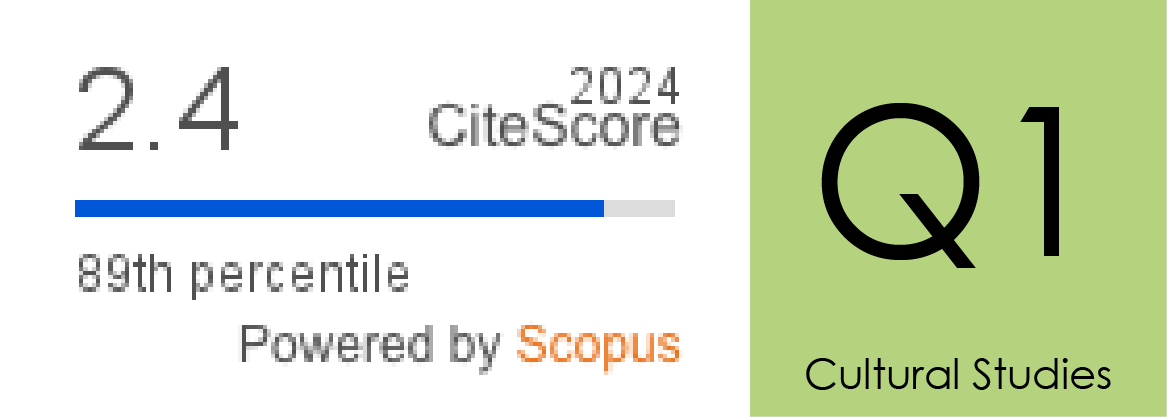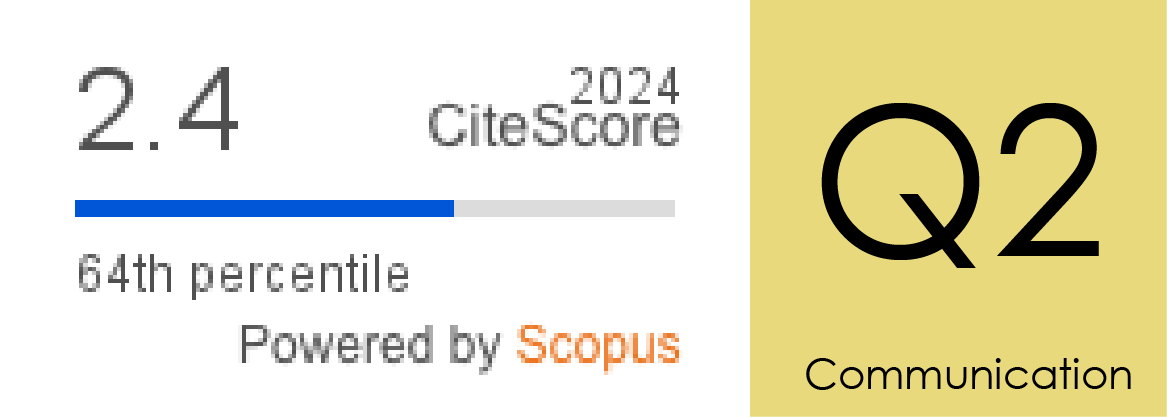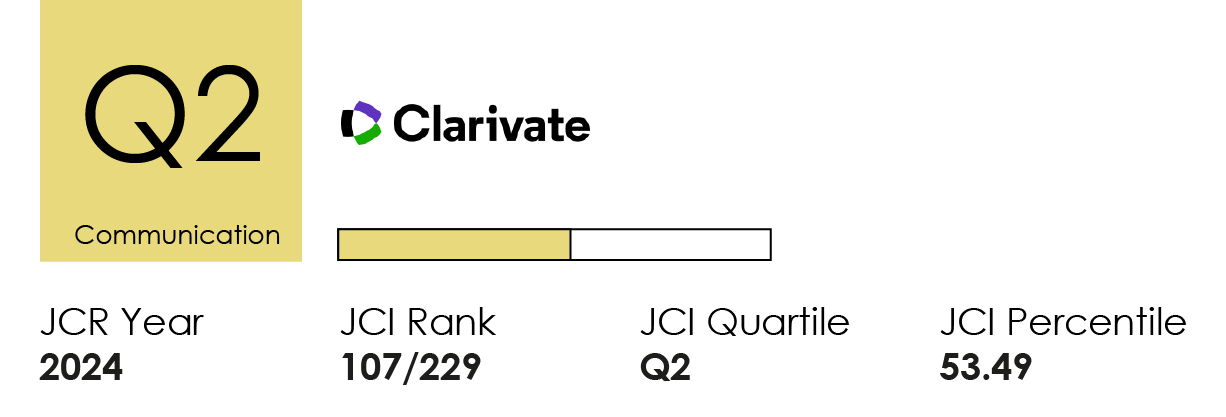Análisis y detección de los trols en el perfil de Twitter de El País España
DOI:
https://doi.org/10.14198/MEDCOM.21867Palabras clave:
detección de trolls, comportamiento antisocial, redes sociales, comunidades en línea, trolling en internet, medios de comunicación masivosResumen
Los trols son una realidad cada vez más presente con la que conviven los usuarios de Internet. El presente estudio pretende confirmar si los trols son una amenaza real en España y, más concretamente, en el perfil de Twitter del periódico más leído de la nación: El País. Mediante el análisis de 767 tuits, se buscaba analizar la frecuencia con la que intervienen los trols en el perfil El País España, caracterizar —en cuanto a sexo y tipología— los trols que intervinieron en esta cuenta de Twitter y comprobar si existe una relación entre el ratio de engagement de las publicaciones y el número de comentarios trolling. Los resultados confirmaron que los trols están muy presentes en el perfil de Twitter de El País España, con un mayor protagonismo de los trols anónimos de tipología hater. Además, el engagement presenta una correlación positiva muy fuerte con el número de comentarios trolling hasta el punto de que es posible predecir este ratio, utilizando para ello el número de comentarios protagonizados por trols. La investigación aporta información de valor que puede resultar de utilidad tanto a nivel teórico como práctico debido a las implicaciones y el carácter innovador que posee.
Citas
Anikweze, C. M. (2013). Measurement and evaluation for teacher education. Constellation Publishers.
Asociación para la investigación de medios de Comunicación. (2021). Estudio General de Medios 3º ola. https://bit.ly/3nD5l1P
Awogbemi, C. A. & Oguntade, E. S. (2010). Elements of Statistical Methods. Suntos Intercontinental Services Ltd.
Barker, V. (2009). Older adolescents' motivations for social network site use: The influence of gender, group identity, and collective self-esteem. Cyber Psychology & Behavior, 12(2), 209-213. https://doi.org/10.1089/cpb.2008.0228
Binns, A. (2012). DON'T FEED THE TROLS! Managing troublemakers in magazines' online communities. Journalism Practice, 6(4), 547-562. https://doi.org/10.1080/17512786.2011.648988
Bishop, J. (2012). The psychology of trolling and lurking: The role of defriending and gamification for increasing participation in online communities using seductive narratives. In H. Li (Ed.), Virtual Community Participation and Motivation: Cross-Disciplinary Theories (pp. 160–76). Hershey.
Bishop, J. (2014). Representations of ‘trols’ in mass media communication: a review of media-texts and moral panics relating to ‘internet trolling’. International Journal of Web Based Communities, 10(1), 7-24. https://doi.org/10.1504/IJWBC.2014.058384
Bowden, J. L. H. (2009). The process of customer engagement: a conceptual framework. Journal of Marketing Theory and Practice, 17(1), 63–74.
Brodie, R. J., Hollebeek, L. D., Juri c, B., & Ilic, A. (2011). Customer engagement conceptual domain, fundamental propositions, and implications for research. Journal of Service Research, 14(3), 252-271. https://doi.org/10.1177/1094670511411703
Brodie, R. J., Ilic, A., Juric, B. & Hollebeek, L. (2013). Consumer engagement in a virtual brand community: An exploratory analysis. Journal of Business Research, 66, 105–114. https://doi.org/110.1016/j.jbusres.2011.07.029
Buba, L. F. y Falola, J. A. (2008). Use of Statistics. En Adamu, Y. M., Mohammed, H. y Dandago, K. I. (eds.), Readings in Social Science Research (pp. 169-182). Adamu Joji Publishers.
Buckels, E. E., Trapnell, P. D., & Paulhus, D. L. (2014). Trols just want to have fun. Personality and Individual Differences, 67, 97-102. https://doi.org/10.1016/j.paid.2014.01.016
Charitidis, P., Doropoulos, S., Vologiannidis, S., Papastergiou, I., & Karakeva, S. (2020). Towards countering hate speech against journalists on social media. Online Social Networks and Media, 17, 1-10. https://doi.org/10.1016/j.osnem.2020.100071
Cheng, J., Bernstein, M., Danescu-Niculescu-Mizil, D., & Leskovec, J. (2017). Anyone can become a trol: Causes of trolling behavior in online discussions. CSCW Conf Comput Support Coop Work, 1217-1230. https://doi.org/10.1145/2998181.2998213
Coatney, C. (2021). Don’t Feed the Trols? Emerging Journalism Practices for Fighting Anti-Semitism. Cosmopolitan Civil Societies: An Interdisciplinary Journal, 13(1), 62–78. https://doi.org/10.5130/ccs.v13.i1.7421
Craker, N., & March, E. (2016). The dark side of Facebook: The Dark Tetrad, negative social potency, and trolling behaviours. Personality and Individual Differences, 102, 79-84. https://doi.org/10.1016/j.paid.2016.06.043
Cruz, A. G. B., Seo, Y., & Rex, M. (2018). Trolling in online communities: A practice-based theoretical perspective. The Information Society, 34(1), 15-26. https://doi.org/10.1080/01972243.2017.1391909
Crystal, D. (2006). Language and the Internet. University of Wales Press.
De Aguilera-Moyano, J.; Baños-González, M., y Ramírez-Perdiguero, J. (2015). Branded entertainment: los contenidos de entretenimiento como herramienta de comunicación de marketing. Un estudio de su situación actual en España. Revista Latina de Comunicación Social, 70, 519–538. https://doi.org/10.4185/RLCS-2015-1057
Dick, A. S., & Basu, K. (1994). Customer loyalty: Toward an integrated conceptual framework. Journal of the Academy of Marketing Science, 22(2), 99–113. https://doi.org/10.1177/0092070394222001
Donath, J. S. (1998). Identity and deception in the virtual community. In P. Kollock, & M. Smith (Eds.), Communities in Cyberspace (pp. 37–68). Routledge.
El Español. (07/03/2017). La táctica de un periódico para acabar con los 'trolls': obligar a leer antes de comentar. El Español. https://bit.ly/3jcj8tx
Elward, B., Laurier, J., & Wyllie, I. (2001). US Navy F-4 Phantom II MiG Killers: 1965–70. Osprey Publishing.
Fenoll, V. (2015). El trol de Internet. Estrategias de los usuarios para controlar el diálogo en los medios digitales durante el juicio de Francisco Camps. Dígitos. Revista de Comunicación Digital, 1, 179-197. http://dx.doi.org/10.7203/rd.v0i1.9.
Fernández, A. (04/01/2017). Cómo calcular el engagement en social media. Social Medier. https://bit.ly/3LIBu1v
Garson, G. D. (2008). Correlation. Statistical Associates Publishers. https://bit.ly/3k8x4We
Gylfason, H. F., Sveinsdottir, A. H., Vésteinsdóttir, V., & Sigurvinsdottir, R. (2021). Haters Gonna Hate, Trols Gonna Trol: The Personality Profile of a Facebook Trol. International Journal of Environmental Research and Public Health, 18, 5722. https://doi.org/10.3390/ijerph18115722
Hardaker, C. (2010). Trolling in asynchronous computer‐mediated communication: From user discussions to academic definitions. Journal of Politeness Research Language Behaviour Culture, 6, 215–242. https://doi.org/10.1515/jplr.2010.011
Hardaker, C. (2013). “Uh.... not to be nitpicky, but… the past tense of drag is dragged, not drug.”: An overview of trolling strategies. Journal of Language Aggression and Conflict, 1(1), 58-86. https://doi.org/10.1075/jlac.1.1.04har
Haro, J. J. (2009). Las redes sociales aplicadas a la práctica docente. Didáctica, Innovación y Multimedia. https://bit.ly/3IfaXqV
Herring, S., Job-Sluder, K., Scheckler, R., & Barab, S. (2002). Searching for safety online: Managing “trolling” in a feminist forum. The Information Society, 18(5), 371–84. https://doi.org/10.1080/01972240290108186
Hollebeek, L. D. (2011). Demystifying customer brand engagement: exploring the loyalty nexus. Journal of Marketing Management, 27(7–8), 785–807.
Hollebeek, L. D., Srivastava, R. K., & Chen, T. (2016). SD logic–informed customer engagement: integrative framework, revised fundamental propositions, and application to CRM. Journal of the Academy of Marketing Science, 47, 161–185. https://doi.org/10.1007/s11747-016-0494-5
Jaakkola, E. y Alexander, M. (2014). The role of customer engagement behavior in value co-creation a service system perspective. Journal of Service Research, 17(3), 247-261. https://doi.org/10.1177/1094670514529187
Jansen, E., & James, V. (2002). NetLingo: The Internet Dictionary. Netlingo Inc.
Jiang, Z., Di Troia, F., & Stamp, M. (2020). Sentiment Analysis for Trol Detection on Weibo. ArXiv. https://doi.org/10.48550/arXiv.2103.09054
La Vanguardia. (28/07/2018). ‘Trolls’ contra periodistas. La Vanguardia. https://bit.ly/3NSlNa6
Madueño, J. J., y Palomo, B. (2015). Trolls y medios: ¿una relación de conveniencia? En J. M. Rodríguez Rodríguez (coord.), Repensar los valores clásicos del periodismo: el desafío de una profesión enredada: actas de las comunicaciones presentadas en el XXI Congreso Internacional de la Sociedad Española de Periodística (pp. 586-607). Sociedad Española de Periodística Universidad San Jorge.
Malthouse, E. C., Haenlein, M., Skiera, B., Wege, E., & Zhang, M. (2013). Managing customer relationships in the social media era: introducing the social CRM house. Journal of Interactive Marketing, 27(4), 270–280.
Molyneux, L. (2015). What journalists retweet: Opinion, humor, and brand development on Twitter. Journalism, 16(7), 920-935. https://doi.org/10.1177/1464884914550135
Moreau, E. (01/11/2016). 10 Types of Internet Trols You'll Meet Online. Lifewire. https://bit.ly/3fxVhCS
Núñez, V. (17/01/2017). Fórmulas para calcular el engagement en redes sociales y el CTR de tus publicaciones. Vilma Núñez. https://bit.ly/36Wy8JH
O’Brien, N., & Ralston, N. (2014). Charlotte Dawson Found Dead. The Sydney Morning Herald. https://bit.ly/3KkAD7w
Okpala, P. N., Onocha, C. O., & Oyedeji, O. A. (1993). Measurement and Evaluation in Education. Stirring-Horden Publishers.
Origami Logic (2016). The Marketer’s Guide to Measuring Social Engagement. https://bit.ly/3FN08fD
Patterson, P., Yu, T., & de Ruyter, K. (2006). Understanding customer engagement in services. In Advancing theory, maintaining relevance, proceedings of ANZMAC 2006 conference (pp. 4-6). Brisbane. https://bit.ly/3EAMoEb
Pfaffenberger, B. (1996). If I Want It, Itʹs OKʺ: Usenet and the (Outer) Limits of Free Speech. The Information Society, 12, 365–386. https://doi.org/10.1080/019722496129350
Phillips, W. (2011). LOLing at tragedy: Facebook trols, memorial pages and resistance to grief online. First Monday, 16(12). https://bit.ly/3KozwDA
Rainie, L., Anderson, J., & Albright, J. (29/03/2017). The Future of Free Speech, Trols, Anonymity and Fake News Online. Pew Research Center. https://pewrsr.ch/3rrl0T2
Sanfilippo, M., Fichman, P., & Yang, S. (2017). Multidimensionality of online trolling behaviors. The Information Society, 34, 1-13. https://doi.org/10.1080/01972243.2017.1391911
Schwartz, M. (2008). The Trols among Us. The New York Times Magazine. https://nyti.ms/3fACYNn
Shachaf, P., & Hara, N. (2010). Beyond vandalism: Wikipedia trols. Journal of Information Science, 36(3), 357–70. https://doi.org/10.1177/0165551510365390
Shah, S. (2004). The internet is Jain: how gunslingin’ technolibertarianism leads to lotus petals. Meat Ball Society. https://bit.ly/34V4XFr
Suciu, P. (04/06/2020). Trols Continue To Be A Problem On Social Media. Forbes. https://bit.ly/33rvLwJ
Thacker, S., & Griffiths, M.D. (2012). An exploratory study of trolling in online video gaming. International Journal of Cyber Behavior, Psychology and Learning, 2(4), 17-33. https://doi.org/10.4018/ijcbpl.2012100102
Thompsen, P. A., & D. A. Foulger (1996). Effects of pictographs and quoting on flaming in electronic mail. Computers in Human Behavior, 12(2), 225–43. https://doi.org/10.1016/0747-5632(96)00004-0
Times. (18/08/2016). How Trols Are Ruining the Internet. Times. https://bit.ly/32fbREI
Torres, A. (15/05/2018). ¿Eres un ‘trol’? Twitter ya sabe cómo identificarte antes de que actúes. El País. https://bit.ly/3IwbnJV
Turner, T. C., Smith, M. A., Fisher, D., & Welser, H. T. (2005). Picturing usenet: mapping computer-mediated collective action. Journal of Computer-Mediated Communication, 10(4). https://doi.org/10.1111/j.1083-6101.2005.tb00270.x
Van Doorn, J., Lemon, K.N., Mittal, V., Nass, S., Pick, D., Pirner, P., & Verhoef, P.C. (2010). Customer engagement behavior: theoretical foundations and research directions. Journal of Service Research, 13(3), 253-266. https://doi.org/10.1177/1094670510375599
Verhoef, P. C., Reinartz, W. J., & Krafft, M. (2010). Customer engagement as a new perspective in customer management. Journal of Service Research, 13(3), 247–252.
Vivek, S. D., Beatty, S. E., & Morgan, R. M. (2012). Customer engagement: exploring customer relationships beyond purchase. Journal of Marketing Theory and Practice, 20(2), 122–146.
Walter, T., Hourizi, R., Moncur, W., & Pitsillides, S. (2011). Does the internet change how we die and mourn? An overview’. Omega: Journal of Death & Dying, 64(4), 12. https://doi.org/10.2190/OM.64.4.a
Webb, S. (23/02/2014). Trolled to Death. Daily Mail. https://bit.ly/32d3v0i
Wilcox, R. K. (1998). Wings of Fury: True Story of America’s Elite Fighter Pilots Pocket. Simon & Schuster.
Descargas
Estadísticas
Publicado
Cómo citar
Número
Sección
Licencia
Derechos de autor 2022 Coral Cenizo

Esta obra está bajo una licencia internacional Creative Commons Atribución 4.0.
Los autores y autoras que publican en esta revista están de acuerdo con los siguientes términos:
1 Derechos de autor. Los autores y autoras conservan sus derechos de autor, aunque ceden a la revista de forma no exclusiva los derechos de explotación (reproducción, distribución, comunicación pública y transformación) y garantizan a esta el derecho de primera publicación de su trabajo, el cual estará simultáneamente sujeto a la licencia indicada en punto 2. Los autores pueden establecer otros acuerdos adicionales para la distribución no exclusiva de la versión de la obra publicada en la revista, siempre que exista un reconocimiento de su publicación inicial en esta revista.
© Los autores.
2 Licencia. Los trabajos se publican en la revista sujetos a la licencia de Reconocimiento 4.0 Internacional de Creative Commons (CC BY 4.0); los términos se pueden consultar en https://creativecommons.org/licenses/by/4.0/
Esta licencia permite a terceros compartir (copiar y redistribuir el material en cualquier medio o formato) y adaptar (remezclar, transformar y crear a partir del material para cualquier finalidad, incluso comercial), siempre que se reconozca la autoría y la primera publicación en esta revista (Revista Mediterránea de Comunicación (RMC) / Mediterranean Journal of Communication (MJC), Universidad de Alicante, DOI de la obra), se proporcione un enlace a la licencia y se indique si se han realizado cambios en la obra.
3 Política de autoarchivo. Se recomienda a los autores que difundan sus trabajos a través de Internet para favorecer una circulación y difusión más rápidas y, con ello, un posible aumento en la citación y alcance entre la comunidad científica y académica, en las siguientes condiciones:
No se permite a los autores depositar en un repositorio institucional o temático, página web propia, etc., las versiones preprint (versión antes de ser evaluada) o postprint (versión evaluada y aceptada para su publicación) de sus trabajos antes de su publicación, pero sí el artículo final publicado (versión del editor).













